Abstract
Purpose
To report the evaluation and comparison of true corneal power after corneal refractive surgery through ARK, Orbscan II®, Pentacam and IOL master.
Methods
Target IOL (Intraocular lens) power calculated with the SRK/T formula using SMK (Sungmo Eye Hospital keratometry), which is a new method for measuring corneal refractive power, was compared with the back-calculated ideal IOL power after cataract surgery for 30 eyes that required cataract surgery and had previously undergone refractive surgery. Target IOL powers calculated using 4 systems were compared with IOL power calculated using the clinical history method for 64 eyes that had undergone refractive surgery.
Results
Using SMK with the SRK/T formula, the actual refraction was within ±0.5 diopter (D) of the intended refraction for 63.8% of eyes and within ±1.0 D for 90.9% of eyes. Compared with target IOL power calculated with the clinical history method, target IOL power calculated by SMK with the SRK/T formula had a difference of 1.95 ± 0.86 D, which was similar to the results calculated by the Haigis-L formula and by TNP with Haigis.
Go to : 
References
1. Holladay JT. Cataract surgery in patients with previous keratore-fractive surgery. Ophthalmic Practice. 1997; 15:238–44.
2. Doh HJ, Sah WJ, Myoung YW. . Accuracy of intraocular lens power in cataract patients underwent excimer laser PRK. J Korean Ophthalmol Soc. 1999; 40:2145–51.
3. Kalski RS, Danjoux JP, Fraenkel GE. . Intraocular lens power calculation for cataract surgery after photorefractive keratectomy for high myopia. J Refract Surg. 1997; 13:362–6.

4. Gimbel HV, Sun R. Accuracy and predictability of intraocular lens power calculation after laser in situ keratomileusis. J Cataract Refract Surg. 2001; 27:571–6.

5. Siganos DS, Pallikaris IG, Lambropoulos JE, Koufala CJ. Keratometric readings after photorefractive keratectomy are unreliable for calculating IOL power. J Refract Surg. 1996; 12:S278–9.

6. Seitz B, Langenbucher A, Nguyen NX. . Underestimation of intraocular lens power for cataract surgery after myopic photo-refractive keratectomy. Ophthalmology. 1999; 106:693–702.

7. Holladay JT. Consultations in refractive surgery. J Refract Corneal Surg. 1989; 5:202–3.
8. Feiz V, Mannis MJ, Garcia-Ferrer F. . Intraocular lens power calculation after laser in situ keratomileusis for myopia and hyper-opia: a standardized approach. Cornea. 2001; 20:792–7.
9. Moon SH, Kwon KL, Kee C. Intraocular lens power calculation in cataract surgery after excimer laser photorefractive keratectomy. J Korean Ophthalmol Soc. 2000; 41:60–6.
10. Seitz B, Langenbucher A. Intraocular lens power calculation in eyes after corneal refractive surgery. J Refract Surg. 2000; 16:349–61.

11. Smith RJ, Chan WK, Maloney RK. The prediction of surgically in-duced refractive change from corneal topography. Am J Ophthalmol. 1998; 125:44–53.

12. Wang L, Booth MA, Koch DD. Comparison of intraocular lens power calculation methods in eyes that have undergone LASIK. Ophthalmology. 2004; 111:1825–31.

13. Kim JH, Do Lee, Joo CK. Measuring corneal power for intraocular lens power calculation after refractive surgery. Comparison of methods. J Cataract Refract Surg. 2002; 28:1932–8.
14. Latkany RA, Chokshi AR, Speaker MG. . Intraocular lens calculations after refractive surgery. J Cataract Refract Surg. 2005; 31:562–70.

15. Ridley F. Development in contact lens theory-moulding, computation, and veiling. Trans Ophthalmol Soc U K. 1948; 68:385–401.
16. Han JW, Kim JH, Joo CK. Comparison for the measuring methods of intraocular lens power to calculate for eyes after LASIK. J Korean Ophthalmol Soc. 2000; 41:2191–7.
17. Hoffer KJ. Intraocular lens power calculation for eyes after re-fractive keratotomy. J Refract Surg. 1995; 11:490–3.

18. Cairns G, McGhee CN. Orbscan computerized topography: attributes, applications, and limitations. J Cataract Refract Surg. 2005; 31:205–20.

19. Kang JH, Park JI, Lee KH. A new method for measuring corneal re-fractive power after refractive surgery. J Korean Ophthalmol Soc. 2005; 46:859–64.
20. Olsen T, Thim K, Corydon L. Accuracy of the newer generation in-traocular lens power calculation formulas in long and short eyes. J Cataract Refract Surg. 1991; 17:187–93.

21. Lee MO, Chung TY, Chung ES, Kee CW. Comparison of intra-ocular lens power calculation methods for cataract surgery after re-fractive surgery: A retrospective surgery. J Korean Ophthalmol Soc. 2010; 51:180–7.

22. Olsen T. On the calculation of power from curvature of the cornea. Br J Ophthalmol. 1986; 70:152–4.

23. Mandell RB. Corneal power correction factor for photorefractive keratectomy. J Refract Corneal Surg. 1994; 10:125–8.

24. Kim SW, Kim EK, Cho BJ. . Use of the pentacam true net cor-neal power for intraocular lens calculation in eyes after refractive corneal surgery. J Refract Surg. 2009; 25:285–9.
Go to : 
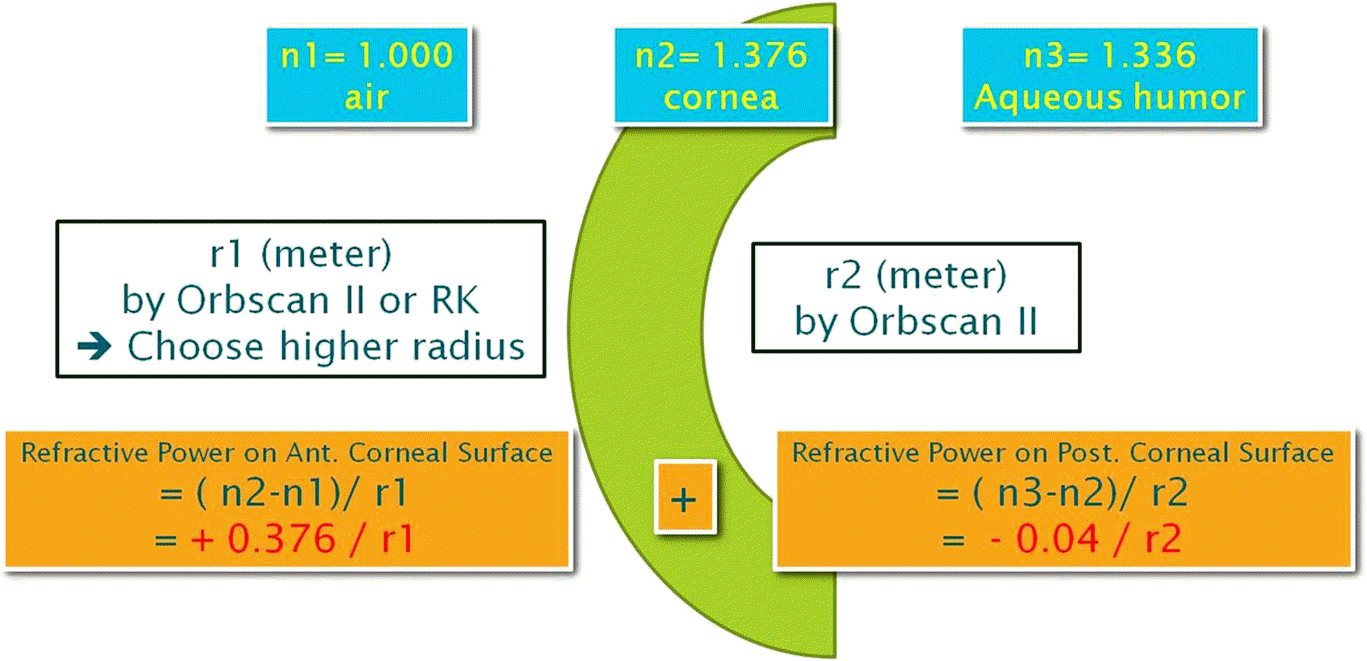 | Figure 1.The SMK calculation based on Gaussian optic formula. This method calculates anterior corneal power and posterior corneal power, respectively and the final keratometry value is the sum of each other. Anterior corneal radius is measured by RK and orbscan. Posterior radius is measured by Orbscan. Anterior and posterior radius is measured on 3 mm in best fit sphere. |
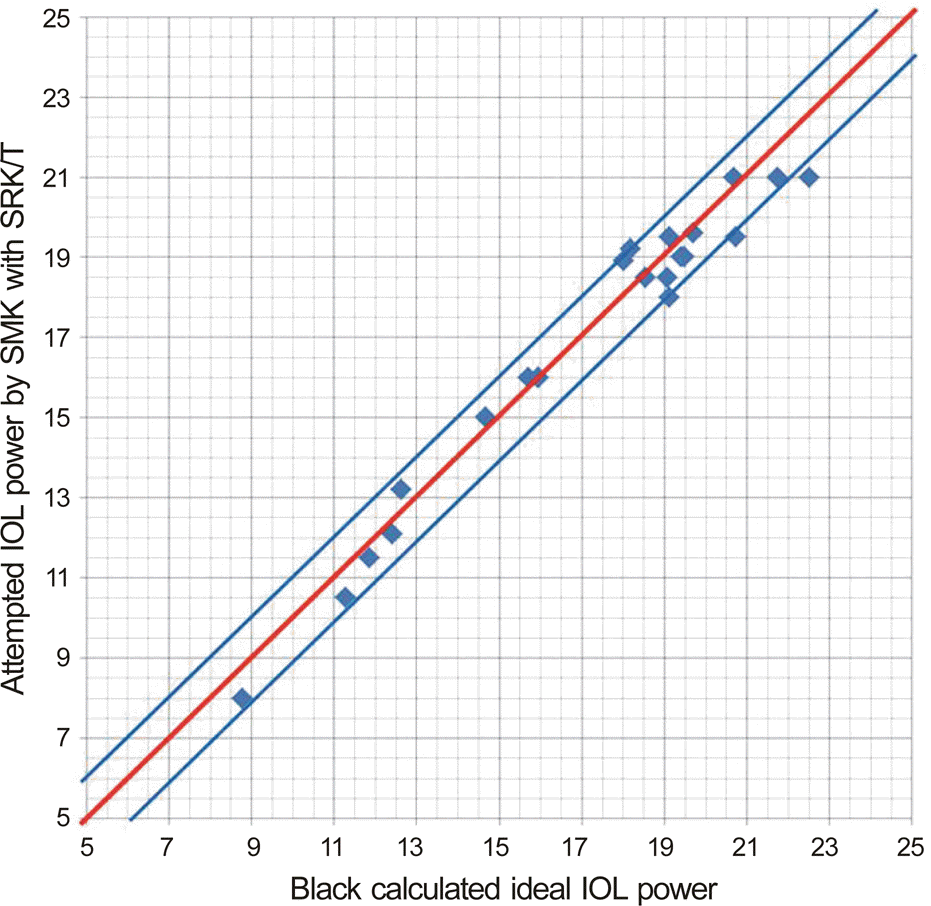 | Figure 2.Clinical Result of SMK with SRK/T formula. From 2008, there are 22 patients who have received cataract surgery after LASIK or PRK. We compared retrograde calculated ideal IOL power after cataract surgery with attempted IOL power by SMK with SRK/T formula. As a result, 63.6% patients have difference within ±0.5 diopter and 90.9% within ±1.0 diopter. The blue line shows range of ±1.0 diopter as a refer-ence marker. |
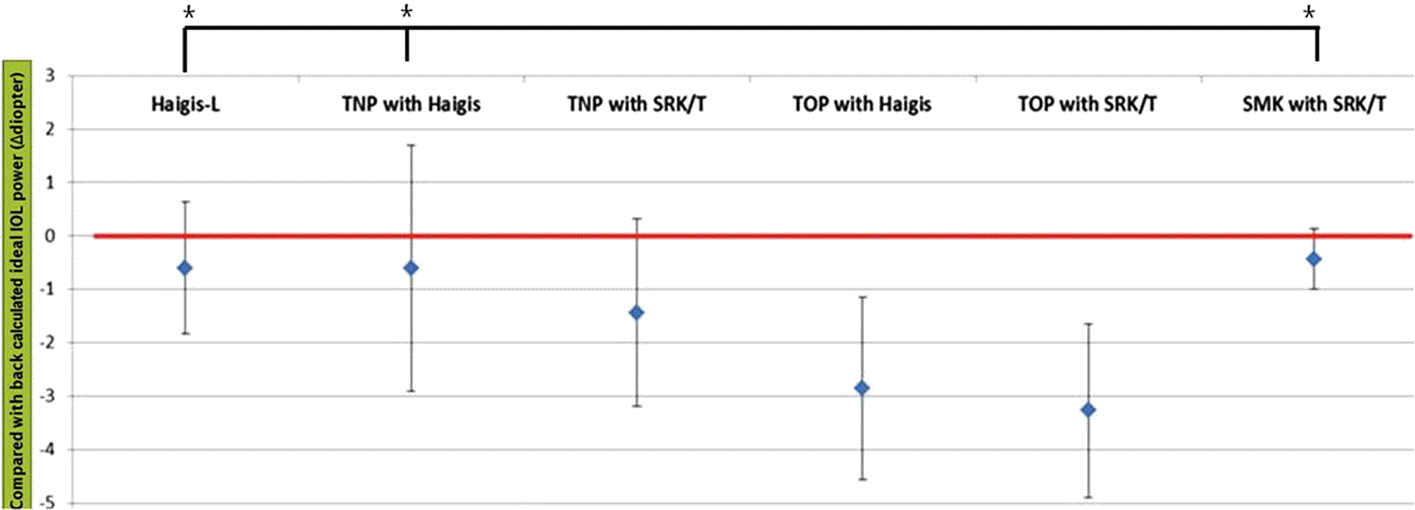 | Figure 3.Comparison with a back calculated ideal IOL power There were no statistically significant difference between Haigis-L, TNP (True net power from Pentacam) with Haigis formula, and SMK with SRK/T formula. TOP = total optical power map. * p > 0.05. |
 | Figure 4.Comparison with multiple keratomerty values from variable devices. Anterior corneal curvature were measured by Orbscan II® (ORB). and autorefractokeratometer (RK), and posterior curvature were measured by Orbscan II® (ORB) and Pentacam (PEN). SMK calculated with anterior curvature data from higher values of ORB or RK, and posterior curvature from ORB. Two IOL calculation formulas were used (Haigis formula and SRK/T formula), respectively. There were no statistically significant difference between multiple keratometry values with multiple formulas and SMK with SRK/T formula. TNP = true net power from Pentacam; ORB = Orbscan II®; PEN = Pentacam®; RK = refractive keratometry. |
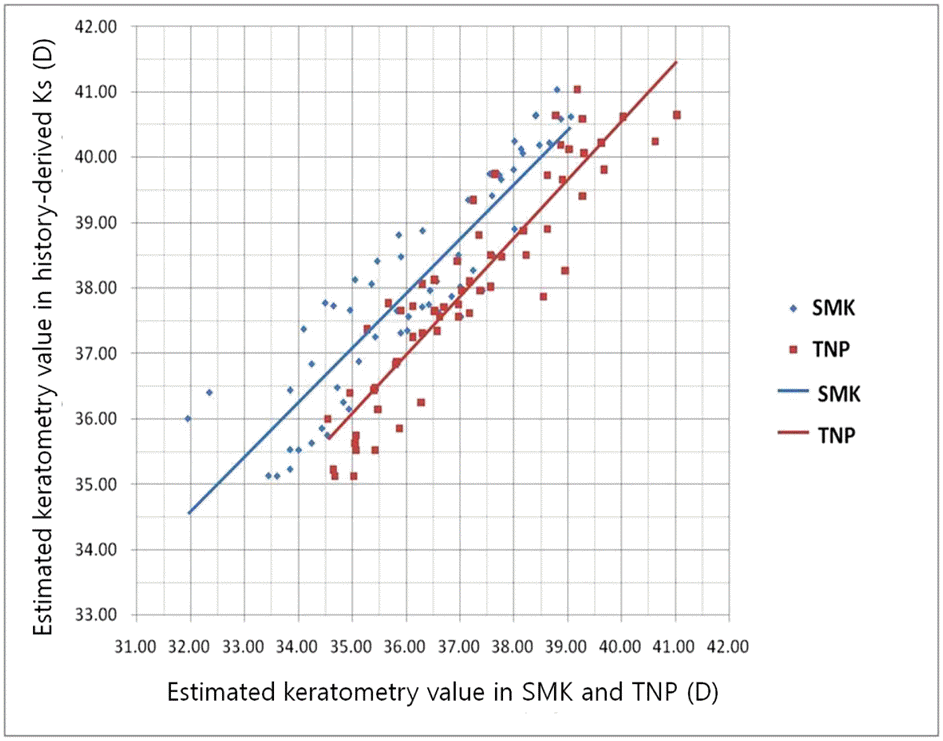 | Figure 5.Comparison of estimated keratometry value (Ks) in the SMK, true net power (TNP) and history-derived Ks. Estimated Ks were statistically significantly different between SMK and TNP (p < 0.05). |
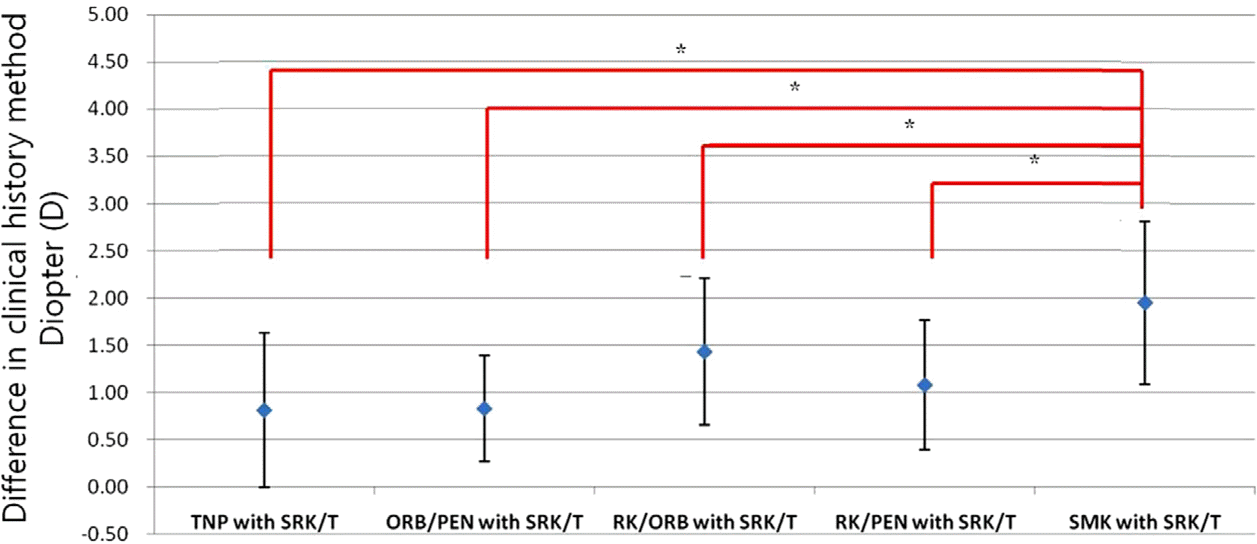 | Figure 6.Compared with clinical history method in SRK/T formula. Target IOL power calculated with SRK/T formula using variable keratometry value. Target IOL power has statistically significantly different compared with SMK with SRK/T. TNP = true net power from Pentacam; ORB = Orbscan II®; PEN = Pentacam®; RK = refractive keratometry. * p < 0.05. |
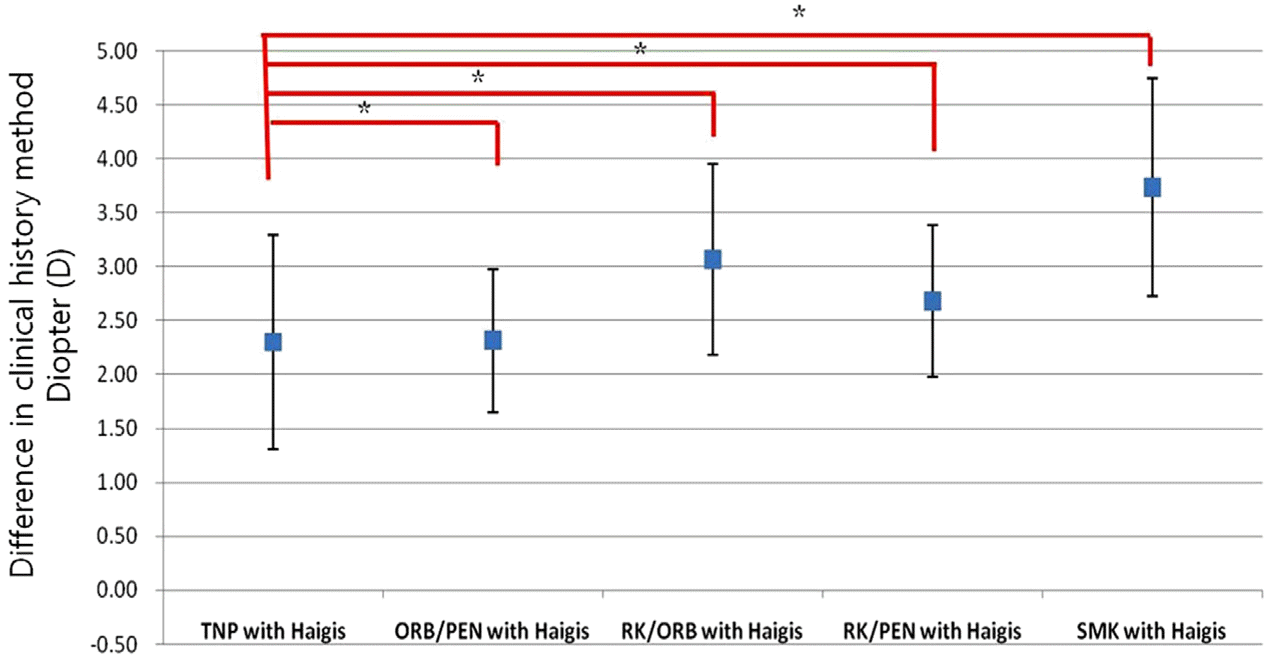 | Figure 7.Compared with clinical history method in Haigis Formula. Target IOL power calculated with Haigis formula using variable keratometry value. Target IOL power have statistically significantly different compared with TNP with Haigis. * p < 0.05. |
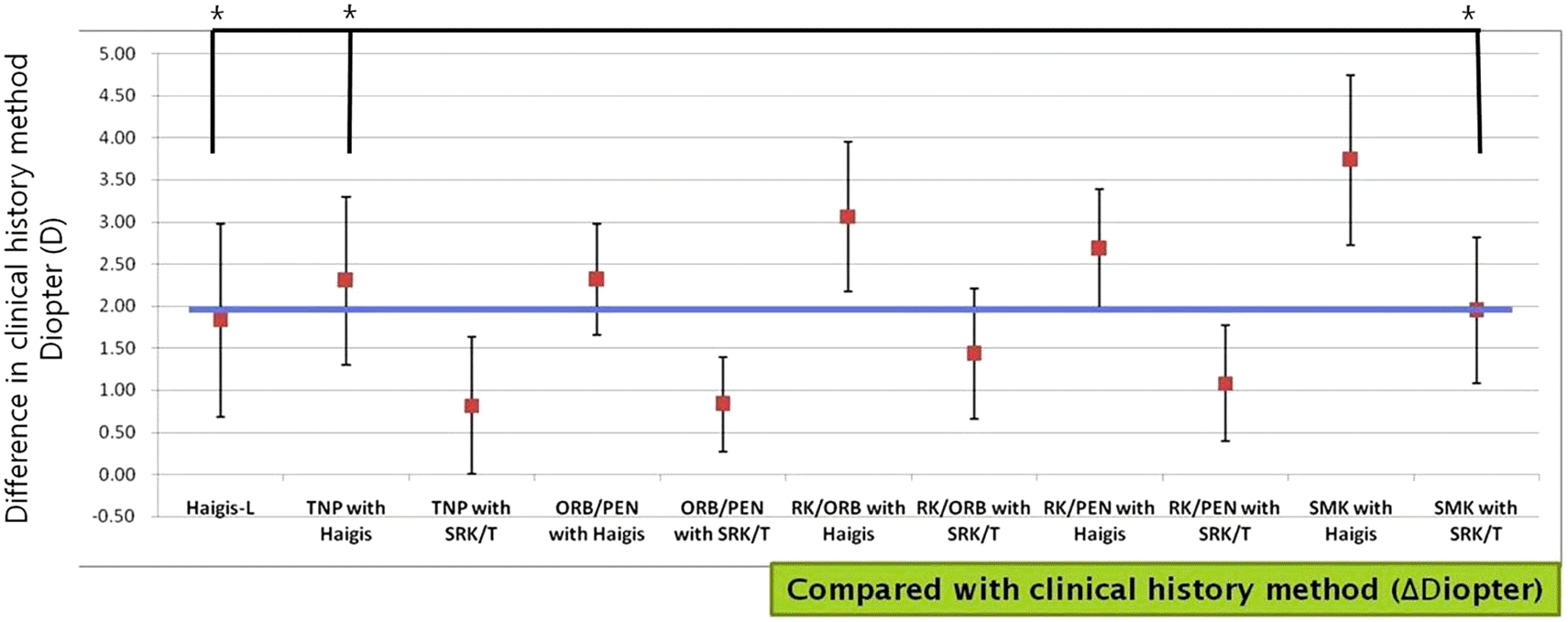 | Figure 8.In comparison with a clinical history method. 64 eyes of 32 patients who received only LASIK have been evaluated. Compared with target IOL power calculated with the clinical history method, target IOL power by SMK with SRK/T formula was different by 1.95 ± 0.86 D. Blue line shows similar results of Haigis-L, TNP with Haigis and SMK with SRK/T which was not statistically sinificantly different from each other. * p > 0.05. |




 PDF
PDF ePub
ePub Citation
Citation Print
Print


 XML Download
XML Download